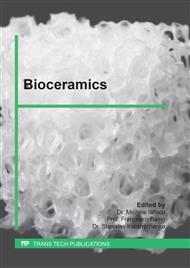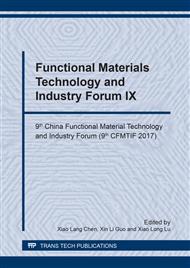p.3
p.11
p.19
p.29
p.37
p.47
p.56
p.64
Characterization of Porous Hyaluronan/β-TCP Scaffolds Prepared through Heterogeneous Crosslinking
Abstract:
Porous Hyaluronan/β-tricalcium phosphate composite scaffolds were synthesized through lyophilizing and subsequent heterogeneous crosslinking method. The morphology of the composite scaffolds were investigated by scanning electron microscopy (SEM). The swelling behavior, mechanical property, degradation behavior and cell adhesion ability of samples were also studied. The results revealed that hyaluronan mainly contributed to the polymer matrix and water adsorption, whereas β-TCP acted as a reinforcement to strengthen the porous structure, while too much β-TCP would make the structure collapse. The pose size of obtained scaffolds ranges from100μm to 200μm and the porosity decreased with the increase of β-TCP content. The degradation behavior and cell adhesion test indicated that increasing hyaluronan concentration can effectively improve the degradability of scaffolds and the incorporation of β-TCP improved the cell adhesion performance. Thus a simple way to prepare hyaluronan-based composite scaffolds was provided, which could be potentially used as an tissue engineering material.
Info:
Periodical:
Pages:
29-36
Citation:
Online since:
February 2018
Authors:
Keywords:
Price:
Сopyright:
© 2018 Trans Tech Publications Ltd. All Rights Reserved
Share:
Citation:



